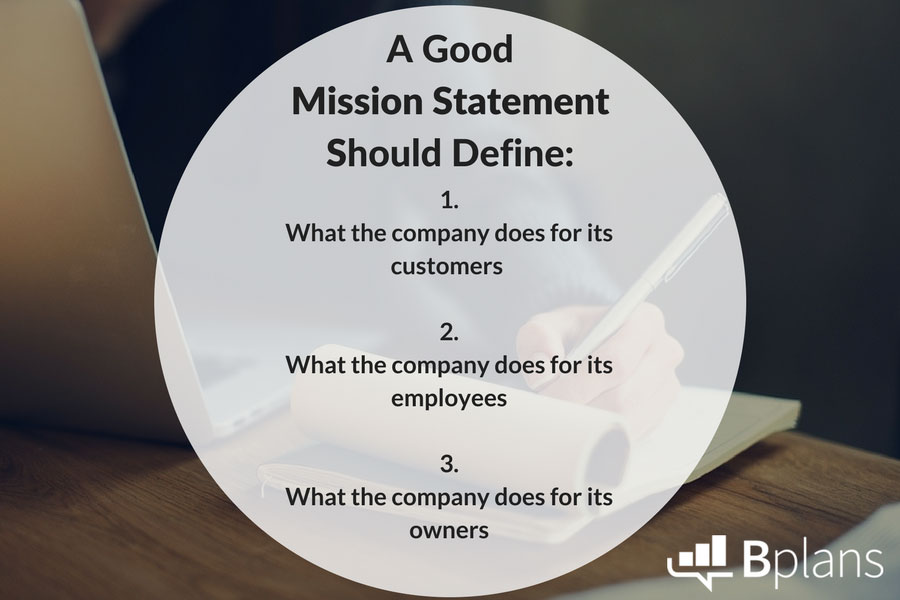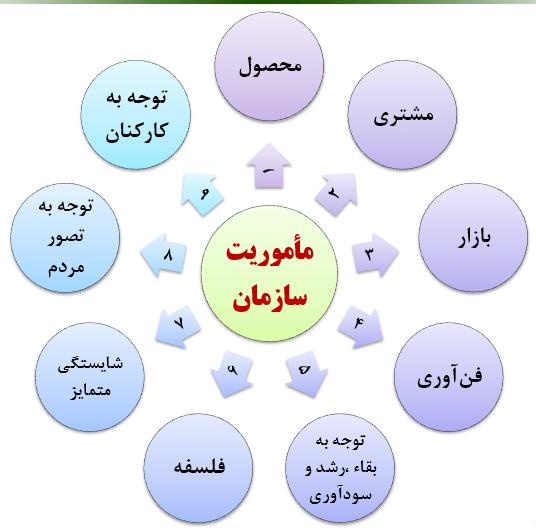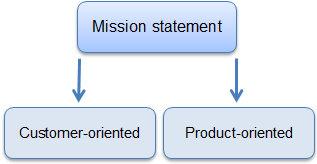بیانیه ماموریت چیست ؟

بیانیه ماموریت توصیفی است از اینکه سازمان در واقع چکار میکند،تجارت آن چیست و چرا اینکار را انجام میدهد.
ماموریت یک سازمان فلسفه وجودی و چرایی فعالیت آن است. هرسازمانی در پاسخ به یک سری نیاز ایجاد می شود و هدف آن رفع آن نیاز می باشد بنابراین قبل از هر اقدام باید مشخص شود پاسخگویی به چه نیازهایی منجر به تشکیل سازمان گردیده است
. به عبارتی بیانیه ماموریت سازمان جمله یا عبارتی است که بوسیله آن مقصود یک سازمان از مقصود سازمان مشابه متمایز می شود و آن بیان کننده علت وفسفه وجودی یک سازمان است و به سوالات زير پاسخ مي دهد:
- سازمان براي پاسخ دهي به چه نيازهايي بوجود آمده است؟
- براي پاسخ دهي به نيازها چه ماموريت و وظايفي را بر عهده گرفته است؟
- هدف و يا اهداف غائي از اجراي فعاليتهاي فوق چيست؟
- چه چیزی می خواهد به جامعه عرضه کند؟
- می خواهد چه محصول یا خدمتی تولید می کند؟
- مشتريان اصلي و مصرف كنندگان نهائي خدمات و يا توليدات سازمان چه كساني هستند؟
- براي تحقق اهداف فوق و انجام وظايف، رعايت چه ارزشها و باورهائي لازم وضروري است؟
بنابراین ماموریت سازمان دلیل وجودی آن است یعنی سازمان برای چه بوجود آمده است ،
دراکر می گوید طرح این پرسش«فعالیت ما چیست؟» مترادف با پرسش «ماموریت ما چیست؟» است همچنین می افزاید یک سازمان برای تهیه بیانیه ماموریت لازم است سوالات زیر را مطرح کند
۱-کسب وکار ما چیست؟
۲-مشتریان ما کیستند؟
۳-ارزش هایی که ما به مشتریان عرضه می کنیم ، چیست؟
۴-کسب و کار ما در آینده چیست؟
۵-کسب و کار ما درآینده چه باید باشد؟
کارکردهای ماموریت
بیانیه ماموریت از ابزارهای مهم در مدیریت استراتژیک اثربخش است زیرا تاثیر زیادی در عملکرد منسجم ، یکپارچه و هم افزای افراد و بخش های مختلف سازمانی دارد به نحوی که موجب می شود انرژی ، منابع و امکانات و قابلیت های سازمان برای تامین اهداف استراتژیک متمرکز شود
ایجاد حس یک رسالت خطیرو ایجاد انگیزه فعالیت
همسونمودن اهداف سازمان در جهت نیازهای جامعه
ایجاد رابطه احساسی-عاطفی
تعیین موضوعات و چالش های استراتژی
ارایه تصویری روشن از سازمان به جامعه و کسب مشروعیت ایجاد و ادامه حیات سازمان
اهميت بيانيه رسالت سازماني
- هدف نهائي سازمان را عملا مورد تاكيد قرار مي دهد.
- مبنا و معيار تخصيص منابع محسوب ميشود.
- جو شناخته شده اي را بر سازمان حاكم مي كند و راهنماي تدوين برنامه ها وفعاليتهاي همه واحدها و افراد قرار مي گيرد.
- زمينه انعطاف پذيري سازماني را فراهم آورد.
- فعاليتها و نتايج حاصله را جهت دهي مي نمايد.
اجزاء بيانيه ماموريت
- نوع خدمت - وظايف و كسب و كارهاي اصلي
- خدمت گيرندگان و مصرف كنندگان خدمات و توليدات
- قلمرو خدمت- منطقه تحت پوشش خدمات يا توليد
- ارزشهاي محوري سازمان
- ويژگي ممتاز سازمان
- + يا - كانون توجه سازمان
- +يا - تكنولوژی

Definition
- Mission statement
- is a description of what an organization actually does – what its business is – and why it does it.
[1]
Understanding the tool
Often called the “credo”, “philosophy”, “core values” or “our aspirations”, organization’s mission is the statement that defines its core purpose or reason for being. [2] It tells who a company is and what it does. According to P. Drucker, often called the father of modern management, a mission is the primary guidance in creating plans, strategies or making daily decisions. It is an important communication tool that conveys information about organization’s products, services, targeted customers, geographic markets, philosophies, values and plans for future growth to all of its stakeholders. In other words, every major reason why company exists must be reflected in its mission, so any employee, supplier, customer or community would understand the driving force behind organization’s operations.
There are two types of statements:[1]

- Customer-oriented missions. Customer-oriented missions define organization’s purpose in terms of meeting customer needs or providing solutions for them. They provide more flexibility than product-oriented missions and can be easily adapted to changing environment. For example, Nokia’s statement “connecting people” is customer-oriented. It does not focus on mobile phones or smartphones only. It provides a solution to customer needs and could easily have worked 50 years ago, and will continue to work in the future. It also gives more strategic flexibility for the company. In Nokia’s case, it may start providing VoIP software to allow calls to be made over the internet and its mission would still be valid.
- Product-oriented missions. Product-oriented missions focus on what products or services to serve rather than what solutions to provide for customers. These statements provide less flexibility for the company because most products have short life cycle and offer limited market expansion. The company that defines its business as “providing best health insurance products” may struggle to grow to other insurance product categories.
For a mission to be effective it must include the following 9 components:[2]
- Customers. Who are your customers? How do you benefit them?
- Products or services. What are the main products or services that you offer? Their uniqueness?
- Markets. In which geographical markets do you operate?
- Technology. What is the firm’s basic technology?
- Concern for survival. Is the firm committed to growth and financial soundness?
- Philosophy. What are the basic beliefs, values and philosophies that guide an organization?
- Self-concept. What are the firm’s strengths, competencies or competitive advantages?
- Concern for public image. Is the firm socially responsible and environmentally friendly?
- Concern for employees. How does a company treat its employees?
Why creating a mission is important?
Many studies have been conducted to find out if having and communicating mission statement helps an organization to achieve higher performance.[3] The results were mixed. Some studies found positive relationship between written statements and higher organizational performance, while other studies found none or even negative relationship. One of the reasons might be that most of the companies create mission statement only because it’s fashionable to do so and little effort is made to actually communicate that mission to its stakeholders. David[2] argues that if an organization constantly revises its mission and treats it as a living document, it achieves higher performance than its competitors. Nonetheless, all of the authors agree that mission brings the following benefits[3][4]:
- Informs organization’s stakeholders about its plans and goals;
- Unifies employees’ efforts in pursuing company goals;
- Serves as an effective public relations tool;
- Provides basis for allocating resources;
- Guides strategic or daily decision making;
- Shows that a company is proactive.
Writing a mission
Creating a mission statement is an important first step in clearly identifying your business’ reason for being. It’s hard to do it right. Therefore, we identified these steps and guidelines to help you write an effective statement.
Step 1. Gather a team of managers, employees and shareholders. Mission is the statement that must be understood by employees of all levels. Involving more people will let you find out how each of them sees an organization and its core purpose. In addition, employees will support organization’s mission more if they will be involved in the process of creating it.
Step 2. Answer all 9 questions for effective mission. Many practitioners and academics agree that a comprehensive statement must include all 9 components. Only then creating a mission can benefit a company. At this stage, try to honestly answer all the questions and identify your customers, markets, values etc. It may take a lot of time but it’s worth it.
Step 3. Find the best combination. Collect the answers from everyone and try to combine one mission statement out of them. During this step, you can make sure that everyone understands company’s reason for being and there are no conflicting views left.
Following guidelines (all taken from various studies) should also be helpful in writing an effective mission statement:
- ‘Public image’, ‘concern for employees’, ‘philosophy’ and ‘customers’ are the most important components of a mission;
- ‘Citizenship’, ‘teamwork’, ‘excellence’ and ‘integrity’ are the values used most often by the companies with effective missions;
- Influential statements include words such as: ‘communities’, ‘customers’, ‘employees’, ‘ethics’, ‘global’ and ‘quality/value’;[4]
- Statement should be customer-oriented;
- Use less than 250 words;
- Be inspiring and enduring.
NOTE! Every mission must be communicated to organization’s stakeholders to have any positive impact.
It must be constantly revised and adjusted to meet any changing situation.
Sources


